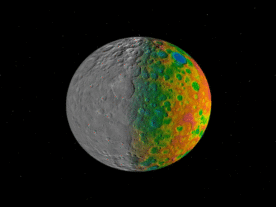
The view from atop Castle Rock. On the horizon you can see open water. (Photo by Refael Klein)
Despite being surrounded by the world’s largest supply of fresh water, the South Pole is driest place on earth. Not a drop of liquid H2O exists—not for hundreds of miles in any direction. Temperatures, which never climb above freezing even on the warmest days of summer, keep our fresh water supply frozen—locked away in plain sight.
Of course, without access to water, Amundsen-Scott Station wouldn’t be here. Water is essential to our everyday living, from cooking meals and mopping floors, to doing the occasional load of laundry and flushing toilets. During an average winter day, the South Pole station uses over 4500 liters (1200 gallons) of fresh water. In the summer, this number can quadruple.
So where does all this water—the cure for our parched mouths, cracked lips, and dry tongues, the source of our most prized luxuries, warm showers and hot coffee—come from? How do we meet our never-ending demand for the elixir of life?
In short, we melt it and pump it into the station.

Ice tunnels run from the lowest level of the main station to the base of the rodwell. Large, heated, insulated pipes carry the water to the station’s treatment plant. (Photo by Refael Klein)
Though basic in concept—apply heat to ice to make fresh water—the process has evolved greatly, especially in the last 20 years. Originally, the station used a massive water maker that had to be manually filled with snow, and heated using warm glycol. This was an energy-intensive set-up and the heavy equipment took a beating, especially during the colder winter months.
In the 1990s, the station switched from the above-ground water maker, to a specially designed “Rodriguez Well,” named for Army engineer Raul Rodriguez, who originally came up with the idea.
The rodwell, as it’s known, is “dug” using a hot water sprayer to melt through the top 30 meters (100 feet) of the ice-cap—an uncompressed layer of snow and air, known as the firn—and burrow into the more dense ice layers below. A pump is lowered into the hole, and hot water warmed by exhaust in the power plant is flushed into the well. That melts more ice, which is then pumped back to the station.
A dizzying trip from the depths of the rodwell up to the surface of the icecap.
Unlike more traditional wells, the rodwell’s effective lifespan is fairly limited. As the well produces more and more water, it becomes deeper and wider. When it reaches a depth of 150 meters (500 feet), it’s no longer efficient to continue pumping water to the surface, and typically a new well is drilled.

The rodwell building houses the entrance to the rodwell as well as the pumps that push and pull water to and fro from the main station. The two hoses from the large coil (right) carry water out of the rodwell at just above freezing, and deliver warm water to melt more snow and ice. (Photo by Refael Klein)
We are currently on the station’s fourth rodwell. This one is about 30 meters (100 feet) below the firn and holds more than 700,000 liters (190,000 gallons) of water. By the end of its life span, it will have produced more than five times that.

Polies, looking for fresh, untreated, 600-year-old ice water, can quench their thirst at the aptly named “mineral water” spigot in the water treatment plant. (Photo by Refael Klein)
As you can imagine, the water we get at the South Pole is some of the purest available on the planet. In fact, there are so few dissolved minerals in it that we end up having to run it through a limestone matrix to increase its mineral content. If we didn’t, it would strip the solder from our pipes and be unhealthy to drink.
Even so, if you are eager to try the fresh “unadulterated” liquid goodness, straight from the depths of the icy continent’s frozen ocean, you can, at a spigot found in our water treatment plant. Bizarrely, the water doesn’t taste much different than the water anywhere else. It’s flavorless, cold and thirst-quenching.
Like the rings on a tree, you can tell the age of any layer of ice by measuring the number of rings above it. With the bottom of our rodwell 60 meters (200 feet) below the surface of the ice-cap, we are melting water from the 15th century. Every time I lean over the water fountain, I’m drinking water that was frozen by the time the Incas built Machu Picchu, and Christopher Columbus set out on his journey across the Atlantic. It’s a bizarre feeling—poor man’s time travel at the bottom of the world.






















Comments are closed.